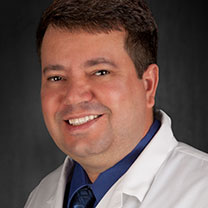Posted by: Eye Centers of Florida in Uncategorized
Age-Related Macular Degeneration: Common & Treatable
 Age-related macular degeneration (ARMD) is a leading cause of irreversible vision loss in older adults. In fact, there are more than 5 million new cases of ARMD diagnosed each year in Europe and North America alone; and it is estimated that 30 percent of Americans 55 years of age and older have ARMD. There are two types of ARMD—dry and wet.
Age-related macular degeneration (ARMD) is a leading cause of irreversible vision loss in older adults. In fact, there are more than 5 million new cases of ARMD diagnosed each year in Europe and North America alone; and it is estimated that 30 percent of Americans 55 years of age and older have ARMD. There are two types of ARMD—dry and wet.
“Dry ARMD accounts for 85 percent of cases”, explains Claudio Ferreira, M.D., ophthalmologist, and retinal surgery specialist. “An accumulation of yellow deposits on the macula—which is the most sensitive part of the retina and the part responsible for central vision—dry ARMD causes a slow but progressive loss of central vision. The other 15 percent of cases are wet ARMD, which is the main cause of rapid central vision loss. The dry form can turn into the wet form, which results in leakage, bleeding, and lipid and pigment accumulation.”
Dr. Ferreira says the disease often starts at the age of 55 and most patients are unaware of the condition. “Many patients with dry ARMD are asymptomatic”, he says. But, others may experience the following symptoms:
- Decreased vision
- A gray spot in the center of vision
- Visual distortion
- Loss of contrast sensitivity
Along with age, there are other risk factors for ARMD, including those that can be changed and those that cannot. Modifiable risk factors include:
- Smoking
- Nutritional factors
- Heavy alcohol use
- Obesity
- Lack of exercise
- Hypertension
- Exposure to sunlight (wearing sunglasses)
Non-modifiable risk factors for ARMD include:
- Gender – ARMD is more common in females
- Race – ARMD is more common in Caucasians
- Family history
- Genetic factors
- Cardiovascular disease
- Diabetes
Treatment is available and differs depending on the form of ARMD. For dry ARMD, Dr. Ferreira says treatment involves:
- Close observation
- Genetic testing, which helps determine individualized eye vitamins needed to slow the progression of the disease
- Increased intake of green leafy vegetables, such as spinach, broccoli, and kale
- Smoking cessation
- Control of hypertension
- Home monitoring using the Amsler Grid to detect sudden changes in vision, such as distortion or wavy lines
“For wet ARMD, the current standard of care is a painless intraocular injection of medication to control the leaking or bleeding blood vessels”, Dr. Ferreira says. “I have performed more than 20,000 intraocular injections with an outstanding success rate. But, on rare occasions, if intraocular injections fail, we can use a laser to treat the source of the leakage”.
Learn more about Age-Related Macular Degeneration and Dr. Claudio Ferreira.